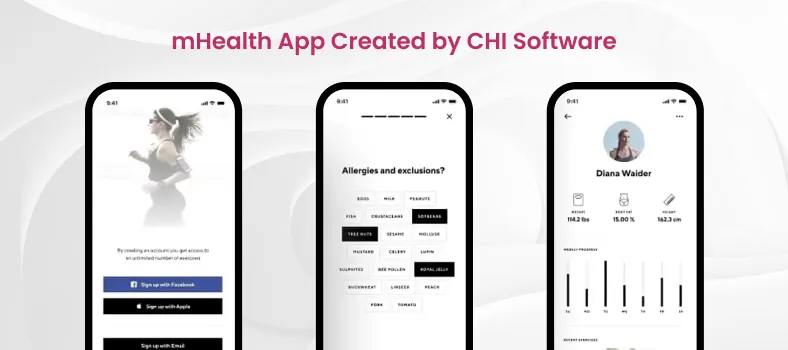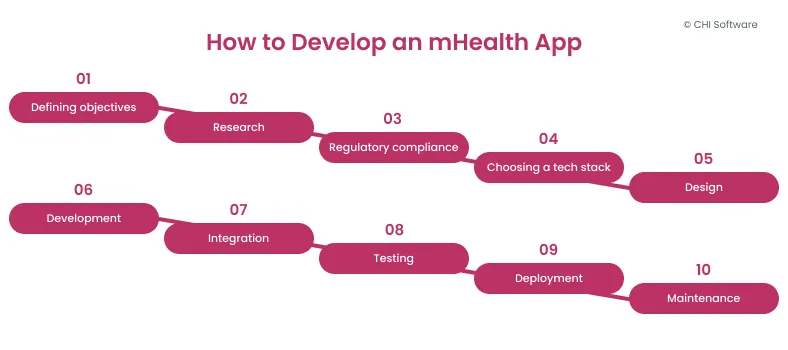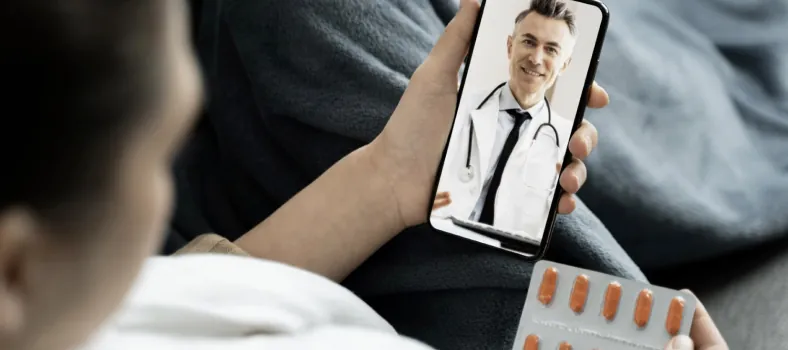Nowadays, most businesses have their own apps for the convenience of consumers. The same applies to healthcare providers and their products – mHealth apps.
According to Statista, the global mHealth market reached 16.9 million USD in 2022 alone. This growth is expected to continue, with forecasts saying the market could grow to 50.5 million USD by 2025.
This clearly shows that the industry’s future is in creating mHealth apps. So, let’s discuss what healthcare apps are and how to develop them.
mHealth Apps and Their Benefits

In the healthcare sector, mHealth is an umbrella term which includes a wide range of apps and appliances with the same goal at the end – to elevate patients’ wellness.
Such apps focus on providing healthcare services and information using real-time remote patient monitoring to give tips for a healthy lifestyle.
The benefits of such solutions are in the ability to provide access to healthcare and promote healthy lifestyles for patients.
- Convenience: Generally, having services accessible through a smartphone is more convenient compared to other methods. For example, if the user doesn’t have a hospital around them and they have questions about mental health, it can be almost impossible to find a convenient solution offline. This is where mHealth apps can help.
- Health monitoring: Another great thing about these solutions is real-time monitoring. By connecting wearable tech like smartwatches to the app, it can monitor a patient’s health metrics. For example, a smartwatch can track their heart rate and sleep patterns, or their phone can track how many steps they take in a day.
- Remote consultations: Let’s be honest: no one likes to go to the doctor’s office. It takes a lot of time, and the whole process can be dreadful. With mHealth apps, it’s a problem from yesterday. The user can consult their doctor remotely via chat or video call.
- Medication management: Some patients may skip their treatment because they forget about it, and this can lead to worse outcomes for them. In order to solve this issue, mHealth apps can remind users to take their medication and keep track of their regime. This improves adherence and ensures expected health improvements from medication.
- Health education: Medical professionals often discourage patients from researching medical information on their own since it can lead to wrong conclusions about their health. Thankfully, mHealth apps can provide supportive information about physical well-being and help patients make informed decisions about it.
IoT Healthcare Solutions: Find Out How to Achieve the Greatest Benefits
Read more
- Lifestyle tracking: In order to make a solution more engaging, some businesses include methods to track users’ progress. It generally improves patient care by encouraging users to make healthier choices.
- Emergency assistance: Some mHealth apps offer emergency call features in addition to regular healthcare services. This feature includes distress contact information, location tracking, and alerts for situations when the user needs assistance.
- Data sharing: There isn’t much point in tracking your health if you don’t know what to do with gathered analytic data! That’s why mobile health apps include data sharing with healthcare providers.
- Personalized recommendations: By analyzing the user’s health-related data, some of the solutions can provide suggestions that will improve the patient’s well-being. For example, recommendations for exercising or supportive information about the diet type.
- Cost-efficiency: The cost of routine consultations or monitoring can add up and become expensive for some patients. mHealth apps are more cost-effective in that regard.
The benefits of mHealth apps are quite extensive, but so is their variety. Before we go into the details of mHealth app development, let’s cover the main types of mobile healthcare solutions.
Types of Healthcare Apps
There are a lot of different types of mobile health apps. Some of them focus only on one specific function, while others can include the whole set of healthcare services. In this article, we will focus on the most common types of wellness solutions.

Telemedicine Apps
This type focuses on allowing both patient and doctor to communicate remotely. It also provides a way for remote patient monitoring and access to clinical records. Let’s cover how it works from both sides.
The process from the patient side looks like this:
- Patient registers on the app;
- They fill in their profile with health information;
- They search for the required doctor and place an appointment;
- The patient communicates with the doctor via text chat or video call.
How to Create a Health Insurance Mobile Application
Read more
For doctors, the process is similar:
- Doctor registers on the app;
- They fill in the information on their profile;
- They go through credentials verification procedure;
- They check their calendar to see the next scheduled patient and their information;
- The doctor communicates with the patient via text chat or video call.
Wearable Apps
The name of this type is self-explanatory. It’s a solution that can be installed on wearable accessories. Think smartwatches, fitness trackers, or smart glasses.
Some people might confuse wearable software with mobile solutions. To clear up this confusion, let’s compare them:
- Wearable solutions have limited functionality compared to their mobile counterparts;
- Wearable apps require less interaction and input from the user;
- Wearable software uses device-specific APIs, while mobile solutions are often cross-platform;
- Wearable apps have supporting mobile apps, while mobile software is standalone.
Wearable technologies are used to collect patient’s health-related data by monitoring their vitals. This data can be used later by the healthcare organization to determine a patient’s diagnosis or detect diseases.
What mHealth app do you have on your mind? Let's discuss your project scope and timeframe.
Leave us a message!
Medical Reference Apps
These solutions are different from others since they are primarily used by doctors. The healthcare industry is constantly changing, and it’s often difficult to keep track of the new latest updates in methods of treatment.
Medical reference solutions provide doctors with access to a vast database of medical information. For example, it includes disease symptoms, treatment guidelines, medical calculators, and so on.
The main idea behind such apps is to provide easy and quick access to information for medical training and the general convenience of healthcare providers. As a result, they enhance the efficiency and accuracy of medical decision-making.
Personal Health Records Apps
Picture this: a patient has moved cities and wants to get set up with a new doctor there. This usually means that the patient needs to drag their medical records from one doctor to another.
On top of that, the doctor might require additional information, which means the patient needs to go back to their original clinic or doctor and request it. Sounds pretty tedious, right?
This is the exact problem personal health records apps solve. Also known as electronic health records (EHR), they store all of the relevant information about a patient’s health history and conditions.
Electronic health records are usually developed by clinics, but there are also third-party versions to make the process of changing healthcare providers that much easier.
Saving Lives with Data: Machine Learning in Healthcare
Read more
Wellness Apps
The general logic behind these solutions is to promote a healthy lifestyle. Think specialized fitness solutions or health monitoring systems. Wellness apps come in different flavors:
- Fitness: These are designed to help patients with personalized recommendations for workout routines and diets. With recent advancements, we have already seen some of these solutions utilize AI for enhanced fitness plans that are tailored to the user.
If you are interested in creating fitness solutions with AI integration, we at CHI Software can provide you with generative AI consulting today and help you step into the field of mobile health apps.
Gamification in Wellness Apps: Keeping Users Engaged and Motivated
Read more
- Mental health: Provides patients with information and supportive resources for managing mental health and life strategies, as well as increased access to healthcare providers and therapists.
- Nutrition and meal planning: These apps serve as “digital nutritionists” by offering custom meal plans and calorie counters. Recently, we’ve even seen integration with grocery shopping platforms.
- Femtech apps: Femtech is short for female technology. They focus on providing wellness support for women’s health needs – think period trackers and maternity apps.
We at CHI Software have experience in custom mHealth app development. Let’s take a closer look at one of the projects in our portfolio.
mHealth Apps Development Features Explained: CHI Software Case Study
During the COVID-19 pandemic, we were contacted by our client from the U.S. to help them develop a health and fitness app. One of the highlights of that time period was the lack of sufficient social interactions due to restrictions recommended by WHO.
This was exactly the problem our client wanted to overcome. Their solution was to create a fitness app that would support and encourage a competitive spirit among the users.
To do that, our client’s main goals were:
- Find a strong mobile team with expertise in custom mHealth app development;
- Receive high-quality services.
We gathered professional developers within two weeks and finished the project in just four months. The resulting software is an excellent example of features your mHealth solution can have. Let’s take a look.

User Personalization
The app collects information about the user’s age, gender, weight, height, etc. Based on this information, the software creates a nutrition or workout plan tailored perfectly to each user.
This feature is important since the user base is very diverse. It creates a need for personalized workout plans and dietary routines.
Wearable Devices Integration
Integration with wearable devices is a must for any wellness app since it helps better track the user’s vitals. The software can track the number of sets the user did and the number of calories burned.
This integration also allows users to gain insights about their personal health. Seeing the fruits of their work keeps them motivated and, thus, more engaged with the app.
Predictive Analytics in Healthcare: Improving the Future with AI
Read more
Daily/Weekly/Monthly Results
This feature provides a summary of a patient’s progress over a given period of time. This encourages users to work out more and offers valuable insights about their workout patterns.
Having this summary not only creates more interest in the user but also helps to set long-term goals accordingly. Both of these points result in higher engagement with the app and provide a more mindful approach to the workout routine.

Setting and Tracking Goals
The app is highly customizable. One of the features is the customization of patients’ goals. For example, the patient may be interested only in working out and not in diet. In this case, they can customize the solution to track their progress only for workouts. The same applies to the diet as well.
Allowing users to set their own goals creates more incentive to continue to train and engage with the app. Plus, it tracks user’s progress and measures their results, making it a perfect match for a workout routine.
Overview of Core Metrics
There are two ways people see the results of their workout routines: by looking at the mirror and looking at the numbers. While it may take some time to see the results of the training, the users still can see the progress in the numbers the app provides.
It offers a full view of key metrics users will be interested in: number of sets done, calories burned, hours spent, etc. This provides insights into the overall health status and shows users areas they might want to improve.
In-App Notifications
To keep users engaged with the app, we’ve added notifications. There are a couple of alert types:
- Reminders to workout
- Progress updates
- Health tips
The solution also allows for customized notifications based on user preferences. Basically, if the user is not interested in one type of notification, they can turn it off.
Would you like to know what mHealth features to build first? Let's discuss your priorities together!
Talk to mHealth experts
Sharing Results Through Socials
For many users, it’s not interesting to do a workout routine without the ability to show it to other people. This is why social network integration has become a necessity.
Users can share their progress directly from the app. This creates an incentive to continue working out in the future to keep showing off their progress.
In-App Community
To add a level of competition between users, the solution comes with a feature to build a community of like-minded people.
In-app communities are a crucial way to connect people with similar goals. It gives motivation and support from other users and also creates engagement with the product for the business.
Our team was responsible for the software’s new component: a leaderboard by location. The feature lists leaders around the world based on local communities, friends, companies, cities, and countries.
This way, each country, city, company, etc., has its own leaderboard, making users compete with their local athletes. This made exercising not just for the sake of itself but also to compete and motivate each other.
If you want to learn more about this project, click here. Meanwhile, let’s talk about mobile health app development.
mHealth App Development: Steps to Follow
The mHealth app development process is trickier than the development of a regular app. It requires deep collaboration between healthcare professionals, developers, and regulatory bodies.

It is important to ensure the app meets standards and follows the regulations of your country and the countries you want to operate. The steps of custom mHealth app development go as follows:
Step 1: Define your objectives
Before you start your development journey, you need to have a clear goal in mind. Define the purpose of the app, the target audience, the type of mHealth app you want to build, and the healthcare services you want to provide.
Step 2: Conduct research and plan out your work
You need to understand what kind of healthcare apps already exist on the market, as well as user needs. This is why you do research. After that, outline the features and functionalities of the app.
Step 3: Ensure regulatory compliance
This is a standardized process that every healthcare organization goes through. The healthcare industry has a lot of regulations around it. It is important to study and understand them, especially the regulations of the country in which you want to work.
Step 4: Choose a development approach
There are a couple of ways you can take in the mHealth app development process. You can create a product with your own team, outsource the project, or use software development platforms. If you are interested in outsourcing the project, you have come to the right place. We at CHI Software can provide you with healthcare AI consulting.
How to Manage Big Data in Healthcare for Better Business Results
Read more
Step 5: Design user interface
You need to create a vision of how your app should look. To do that, create mockups of the user interface and iterate on the design ideas. The main points to focus on are applicable to the design of any smartphone solution: user-friendly interface and visual appeal.
Step 6: Develop your solution
It’s time to transform those ideas from paper into the real world! This is where healthcare app development starts. Develop core features and implement the design.
Step 7: Integrate third-party services
You might want to integrate your app with wearable tech for better monitoring or third-party services for payment processes or analytic tools.
Step 8: Test your app
After the development is complete, it’s time to test the fruits of your labor. Focus on usability, performance, and security.
And don't forget about cybersecurity in your healthcare solution!
Read our guide
Step 9: Deploy your product
After all noticeable bugs are fixed, your app is ready to be deployed. However, the development cycle is not over yet.
Step 10: Maintain and update your app.
Regularly update the software to fix bugs and add new features. It is important to support the product in order to collect as much value from it as possible.
How Much Does It Cost for Healthcare Mobile App Development?
The cost of mHealth app development varied based on multiple factors. Here are some of them:
- Complexity of features: The number and complexity of features directly influence the development hours, which affects the cost of the development.
- Technology: Implementing newer technologies like generative AI or computer vision will cost more compared to older technologies on the market.
- Number of supported platforms: Each platform comes with its own set of standards and software guidelines. The more platforms you want to support, the more development time it will take.
- Team experience: As we already said, quality costs money. The more qualified team of experts will ask more for their working hours compared to less knowledgeable teams.
- Regulatory compliance: Staying compliant with the regulations makes the development process less streamlined. Developers will need to take extra steps, which will be reflected in their development hours.
Based on these factors, the rough price range of an mHealth app for iOS or Android is from 118,500 USD to 158,000 USD. To get a more concrete estimation, you should contact the development team. The price we provided should help you better plan your budget.
Challenges of mHealth Apps

Despite all the benefits of healthcare apps, there are some challenges that you need to consider when going into the healthcare sector. Let’s talk about them.
Regulation compliance:
It is highly advised that you get approval from your country’s regulatory bodies. With their approval, you will be able to release the product for public use. However, each country has its own set of laws.
This means that if you want to start mHealth app development that will operate in multiple countries, you will need to comply with the rules of every country in which you work.
Security:
Since healthcare apps contain a lot of sensitive patient data, you need robust security. Sadly, there have been a lot of cases of patient data being stolen due to an unsecure storage infrastructure.
This is why you have to make sure that your solution is secure. You must also let the users know that you collect personal data, and they can remove all their patient data if necessary.
Interoperability:
There is a reason most healthcare apps stay on smartphones. With a continuously growing number of smart devices, it is hard to optimize and connect your software to each one.
This is due to the lack of software standardization in wearable tech. Most of the apps that allow interoperability are tied to a specific brand of wearable tech or a specific set of devices.
Now that we have covered both the benefits and challenges of healthcare apps and the mHealth app development process, you know everything you need to start your own journey.
Conclusion
mHealth apps are very diverse in functionality and uses. From tracking your vitals and helping you customize your workout routine to mental health monitoring and overall patient care – there’s hardly a point they don’t cover.
In this article, we have introduced you to this technology and explained the basics of Mhealth app development. However, development could be tricky if your team doesn’t have the proper expertise.
Luckily, we at CHI Software have it. We can provide you with healthcare consulting today and help you step into the field of mobile health apps.
About the author
With 5 fabulous years under his belt, Artem is an iOS developer with experience in everything from healthcare and social apps to food & booking platforms and even entertainment. He's a wizard at crafting apps that are not just easy to use but totally engaging. Whether Artem's building an app from square one or stepping in mid-project, he's a go-to expert for making digital magic happen.
Rate this article
22 ratings, average: 4.5 out of 5








